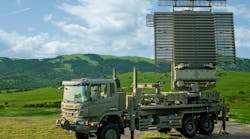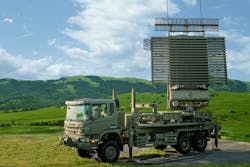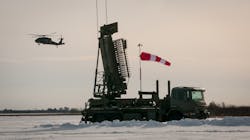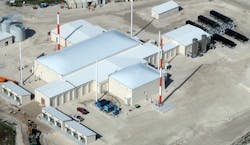One of the most significant developments in the RF/microwave industry has been the rise of gallium-nitride (GaN) technology. Lockheed Martin, which has been involved with GaN development since 2000, is currently utilizing GaN to develop cutting-edge radar systems. The company has experience developing GaN-based solutions through millimeter-wave (mmWave) frequencies.
GaN technology is generally associated with high-power amplifiers (HPAs). While Lockheed Martin is active in this area, its engineers are also utilizing GaN to design other RF components, such as low-noise amplifiers (LNAs), switches, and mixers. Lockheed Martin does not actually have its own GaN foundry, but rather works with commercial foundry partners to allow for strategic growth.
One significant GaN-based radar system from Lockheed Martin is the TPS-77 multi-role radar (MRR) system (Fig. 1). The TPS-77 MRR is the latest entry to Lockheed Martin's product line of surveillance radars. Leveraging GaN technology, the TPS-77 MRR is designed for ultra-low power consumption.
1. Here, the TPS-77 MRR is mounted in a truck in the deployable mobility configuration. (Courtesy of Lockheed Martin)
The TPS-77 MRR, which operates from 1,215 to 1,400 MHz, can be configured for medium- or long-range. It’s mountable on vehicles and easily transportable via a C-130, truck, rail, or helicopter. Example missions for the TPS-77 MRR include unmanned-aerial-vehicle (UAV) detection, low-level flight surveillance, ground-based air defense, etc.
The radar system’s multi-role single-scan technology allows operators to select multiple missions for the radar at a single time, such as medium- or long-range low-level flight surveillance. It automatically adjusts to the selected mission as the radar rotates through each 360-degree scan. Changes can be made if the system is moved or if the mission is changed.
Lockheed Martin recently completed a successful site-acceptance test of its TPS-77 MRR (Fig. 2). The company made an on-time delivery of the first of three radars to the Ministry of Defense of the Republic of Latvia. Lockheed Martin noted that this was a “major step forward in strengthening Latvia's national defense.”
2. This is the TPS-77 MRR in Latvia during a site-acceptance test earlier this year. (Courtesy of 22nd Mobile Public Affairs Detachment)
According to the company, “TPS-77 MRR plays a vital role in improving the Latvian Air Force's airspace defense by increasing its identification capabilities, leading to enhanced early warning and situation awareness that allows its armed forces to make more informed and efficient decisions in response to modern day threats.”
Also powered by GaN technology is Lockheed Martin’s Space Fence system (Fig. 3). Space Fence is a ground-based system of GaN-based S-band radars that’s designed to enhance the Air Force space-surveillance network. Lockheed Martin has partnered with Wolfspeed to provide GaN-based HPAs for the Space Fence system.
3. Shown is an aerial view of the Space Fence facility, Kwajalein Atoll. (Courtesy of Lockheed Martin)
The main purpose of the Space Fence is to detect, track, and catalog the innumerable number of objects in space. According to Lockheed Martin, Space Fence technology will allow for a 10-fold increase in the amount of space-junk tracked in comparison with the current system. The Space Fence system not only tracks objects, but also precisely determines their projected orbit. This allows operators to reconstruct recent events, such as collisions and satellite breakups, as well as accurately predict future ones.




